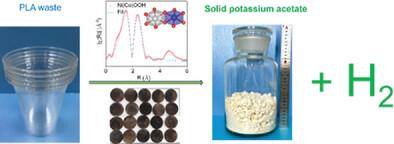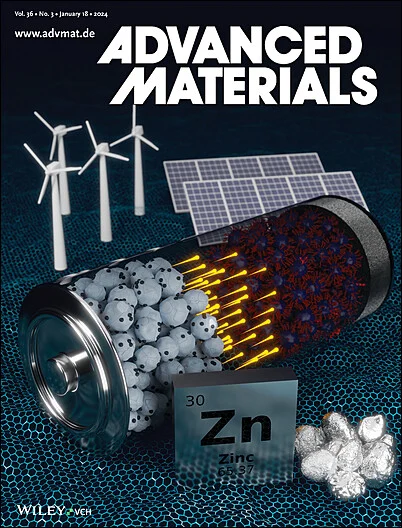High-Performance Electrocatalysts of Potassium Lactate Oxidation for Hydrogen and Solid Potassium Acetate Production
IF 27.4
1区 材料科学
Q1 CHEMISTRY, MULTIDISCIPLINARY
引用次数: 0
Abstract
With the increasing use of polylactic acid (PLA), more attention is turning to its post-treatment. Current methods such as natural decomposition, composting, and incineration are limited by significant carbon dioxide emissions and resource waste. Here, an efficient electrocatalytic conversion approach is presented to transform PLA waste into high-value chemicals, particularly potassium acetate (AA-K). By combining experimental and theoretical calculation, a high-performance catalyst Ni(Co)OOH is developed, which exhibits a current density of 403 mA cm⁻2 at 1.40 V (vs RHE) with 96% Faraday efficiency for AA-K in the electrooxidation of potassium lactate (LA-K, the product of PLA degradation in KOH). Through in situ spectroscopy techniques and density functional theory calculations, the structural regulation of the catalyst, and reaction pathways of the electrooxidation are elucidated. Further experiments demonstrate the superior catalytic performance of the Ni(Co)OOH catalyst in an industrial-scale tandem system. In 2 h of electrolysis, 320 g of PLA waste produces 232 L of H₂, yielding 1200 g of AA-K with 97% purity after neutralization and drying. The system demonstrates high conversion efficiency (approaching 97%) for diverse real PLA waste forms, including powder, cups, fibers, and cloth. This research provides a scalable and sustainable approach for PLA waste upcycling.

求助全文
约1分钟内获得全文
求助全文
来源期刊

Advanced Materials
工程技术-材料科学:综合
CiteScore
43.00
自引率
4.10%
发文量
2182
审稿时长
2 months
期刊介绍:
Advanced Materials, one of the world's most prestigious journals and the foundation of the Advanced portfolio, is the home of choice for best-in-class materials science for more than 30 years. Following this fast-growing and interdisciplinary field, we are considering and publishing the most important discoveries on any and all materials from materials scientists, chemists, physicists, engineers as well as health and life scientists and bringing you the latest results and trends in modern materials-related research every week.
 求助内容:
求助内容: 应助结果提醒方式:
应助结果提醒方式:


